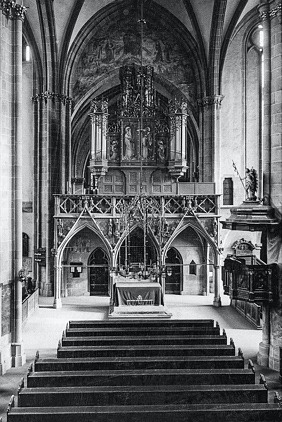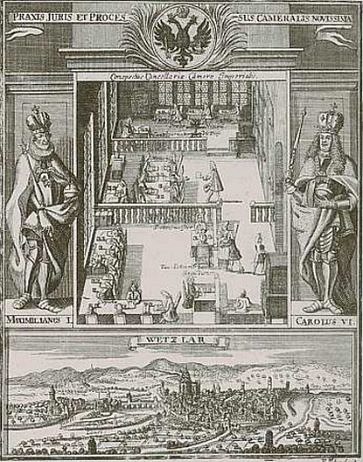History (Video)
History (Text)
1100 years of church history also means 1100 years of architectural history. Like art, architecture also evolves over the millennium. Wetzlar Cathedral offers an experience that is unique in Germany. All architectural epochs in church construction from the 12th to the 16th century can be found here.

Salvator Church
Today’s cathedral is consecrated as the Salvator Church around 900 years after Christ. Its first dedication is thus to Jesus Christ, the Saviour of the world.
Remains of this church have been found under today’s choir in the eastern part of the cathedral.
Late Romanesque collegiate church

The Salvator Church is followed about 100 years later by a late Romanesque collegiate church. This is a church with its own rights and properties, maintained by a non-monastic community of clergy called the college of canons. Two dukes are the founders of the Marienstift, which will play an important role for the cathedral and for the town of Wetzlar in the course of the following centuries. This church is also still visible today. The Romanesque tower, the so-called Heidenturm and the Heidentor are components from this era.
The terms “Heidenturm” (pagan tower), “Heidentor” (pagan gate) and also “Heidenhof” (pagan courtyard) seem unusual to us today. They come from the fact that the people who enter this courtyard for the very first time, and make their way into the church through the entrance portal, are considered pagans, meaning they are unbaptised. They leave it again baptised and thus as Christians..jpg)
Gothic cathedral
The collegiate church remains a comparatively modest building in the small market town of Wetzlar for another 200 years. It is not until 1230 that construction begins on the cathedral we see today. In the meantime, the town has gained the special attention of Emperor Frederick Barbarossa. Wetzlar owes this to its geographical location. Two important trade routes cross here: One runs from Antwerp to Frankfurt.
The other runs from Mainz to Lübeck. Emperor Frederick Barbarossa grants the town the rights of an imperial city, and trade and crafts flourish as a result.
At the same time, the collegiate church also becomes the parish church, in other words, the main church for Wetzlar’s Christians.
Another 260 years pass before this new construction is completed. The wooden spire on the south tower ends the last Gothic construction phase at this time.

Now, 260 years without a church service would have been a long time. The solution is simple: the new church is built around the previous building so that services can continue to be celebrated inside. After completion of the new church, the walls of the old place of worship can be removed.

During the construction phase, several altars are also donated, which have their place in the north and south aisles.
Just as Protestant and Catholic Christians share the cathedral today, the collegiate canons share the church with ordinary churchgoers back then. Around 1340, a rood screen is built to separate the choir area from the rest of the church. The choir area is reserved for the canons and their staff.
In the 15th century, financial hardship in the city leads to the suspension of all construction on the cathedral. The north tower can only be completed up to the first floor. The plan of the canons for two imposing church towers and magnificent portals is never completed.
It is precisely this imperfection that is impressive evidence of Wetzlar’s chequered history. And it continues, for the cessation of construction coincides with the beginning of the Reformation in Europe. In 1542, the town council officially professed the Protestant faith. This marks the beginning of the decline of the Catholic Marienstift. Only the canons and their servants remain Catholic. In the cathedral, only the choir area still belongs to them. The remaining part — including the nave, south aisle and north aisle — are used by the Protestant congregation. Two denominations under one church roof. To this day, Wetzlar Cathedral is one of the oldest simultaneous churches in Germany.


Towards the end of the 17th century, there is a flicker of hope. The imperial city of Wetzlar becomes the seat of the supreme court for the Holy Roman Empire of the German Nation. This glimmer of hope does not last long.
1806
A good 100 years later, in 1806, the Holy Roman Empire of the German Nation ends and, with it, the period of the Imperial Chamber Court and Wetzlar’s status as an imperial city. A considerable loss of inhabitants and great poverty are the consequences.

This impoverishment is also reflected in the structural condition of Wetzlar Cathedral.
It is not until the middle of the 19th century that extensive renovation work is carried out. In the course of the renovation, the dominant Protestant congregation removes Catholic regalia and all the remaining altars in the side aisles. The builders raise the floor of the church up to one metre and equip the nave and side aisles with pews, where people pray and worship to this day.The second comprehensive renovation takes place from 1904 to 1910. At this point, the cathedral’s structural condition has deteriorated so much that it is on the verge of closure. The removal of this immense structural damage swallows up around one million marks, which today corresponds to a purchasing power of around six million EURO.
In 1933, after more than 1000 year of belonging to the diocese of Trier, the small Catholic cathedral parish was subordinated to the diocese of Limburg.Second World War

Up until the end of the Second World War, there is peace and quiet with regard to further maintenance of the cathedral. A calm that is shattered on the 8th of March 1945, when an American aerial bomb falls on the cathedral, destroying centuries of architecture in one fell swoop.
As with everywhere else in Germany, now is the time for reconstruction in Wetzlar. By the end of the 1950s/beginning of the 1960s, the bomb damage to the cathedral has also been repaired. The rood screen, however, no longer exists.The increase in the Catholic population due to the large number of displaced persons after the Second World War is gratifying. A joint use of the church by both denominations, as exemplified by its collegiate forefathers and the Protestant congregation, therefore continues. Wetzlar Cathedral remains a place of worship for ecumenical togetherness.
.jpg)
Spiritual thoughts
1 Moses 2 (4-9, 15)
4These are the generations of the heavens and of the earth when they were created, in the day that the LORD God made the earth and the heavens,
5 And every plant of the field before it was in the earth, and every herb of the field before it grew: for the LORD God had not caused it to rain upon the earth, and there was not a man to till the ground.
6 But there went up a mist from the earth, and watered the whole face of the ground.
7 And the LORD God formed man of the dust of the ground, and breathed into his nostrils the breath of life; and man became a living soul.
8 And the LORD God planted a garden eastward in Eden; and there he put the man whom he had formed.
9 And out of the ground made the LORD God to grow every tree that is pleasant to the sight, and good for food; the tree of life also in the midst of the garden, and the tree of knowledge of good and evil.
…15 And the LORD God took the man, and put him into the garden of Eden to dress it and to keep it.